How to drain water from a site with your own hands, types of drainage systems, technology for their implementation

The question of how to drain water from a site with your own hands appears in the life of a homeowner at least once. If everything is done efficiently, the issue will be resolved forever.
Otherwise, you will have to observe the swamp on the site for life.
A well-equipped sewage system is not always the work of professionals.
Some types of drainage systems are not difficult to build with your own hands, they have a budget cost, and their efficiency and durability are not inferior to engineering systems created by specialists.
Content:
- What is drainage and in what cases is it necessary?
- Site drainage technology, types of drainage systems
- How to drain water from a site with your own hands using deep drainage
- Open drainage of the site without the use of pipes
- How to dry an area with your own hands, how to remove water
- Open drainage of the site without the use of pipes
- How to get rid of water on a site using point and linear drainage
What is drainage and in what cases is it necessary?
Drainage is the removal of excess surface stormwater and deep groundwater from a site. To eliminate them, a comprehensive installation of various hydraulic structures is carried out: canals, pipes, drainage systems, storm drains.

When water stagnates in the area, erosion and destruction of the foundation occurs, fertile layers of soil are washed away, destruction plant root system. And the puddles themselves disrupt the aesthetic appearance and ease of movement around the site.
At risk of flooding are land holdings located on a steep slope, in lowlands, in areas of shallow groundwater, and on flat landscapes.
The hydrological regime of the earth can be determined in several ways:
- asking neighbors about soil quality and the timing and intensity of stormwater and wastewater collections;
- conducting independent research on the depth of groundwater. There are several ways to do this, the simplest of which is to dig a hole more than a meter deep and watch for several days how quickly it fills with water. If water appears at a depth of less than a meter from the surface, drainage in such an area is necessary;
- Using a visual inspection, determine the topography of the site, drawing mental lines of natural drainage of accumulated water, assessing the degree of their slope and hypothetical intensity. On a site located on a steep slope, fertile soil will be washed away at the first heavy rain or spring snow melt. On the plain, on the contrary, the waters, not being able to drain somewhere, will collect in puddles;
- determine the type of soil and decide on the need to install a drainage system if the soil is clayey, viscous and prevents the absorption of water into it.
Almost all areas of the European part of Russia have clayey soil, therefore, drainage in summer cottages, in private country households, is a necessary condition for maintaining the local area in an acceptable form.
Site drainage technology, types of drainage systems
Drainage systems are divided according to the type of occurrence into:
- open, made up of trenches dug throughout the site;
- closed, including underground pipes and channels.
According to technological features they are divided into:
- deep;
- vertical;
- superficial.
The surface system includes hydraulic structures:
- point, designed to collect water in certain areas of the site;
- linear, draining water from the entire surface of the site.
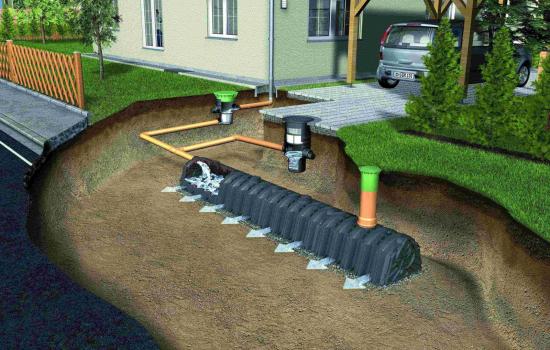
A deep hydraulic complex consists of a system of pipes laid in deep trenches that drain water into a collector well or collection pipe.
A vertical drainage complex consists of several wells for collecting water, which is subsequently drained outside the site by water pumps.
The technology for arranging a drainage system on your own is available for surface and deep types of drainage.
It is better to entrust the construction of a vertical complex to professionals, since in this case special knowledge is required to carry out engineering calculations.
When using drains - drainage pipes - first, trenches are dug into which pipes with a diameter of 50-150 mm are laid on a layer of sand and crushed stone. They are covered with permeable gravel and buried. For the collector pipe, a larger size is used - pipes 200 mm in diameter.
How to drain water from a site with your own hands using deep drainage
The step-by-step creation of a deep drainage system is as follows:
- Development of a plan for the location of drains, collector pipes and wells.
- Digging trenches and preparing their inner surface - laying out sand and crushed stone.
- Laying pipes at an angle to ensure spontaneous flow of water into collector structures.
- Sprinkling pipes with crushed stone for better water permeability of the layer above them. Filling the trench with soil and compacting the soil over the drainage line.
- Creation of collector structures from which collected moisture is discharged into the nearest body of water or ravine.
To ensure maximum efficiency, compliance with the rule for the depth of drains, which must be below the groundwater level, is required.
The advantages of this type of drainage are inconspicuous location, high efficiency and long service life, provided that high-quality materials are used.
Open drainage of the site without the use of pipes
Open drainage without the use of pipes is carried out by constructing trenches and channels through which water flows under the influence of gravity.
Therefore, the beginning of open drainage should be arranged at the highest location of the site, and the collector should be located in the lowland.
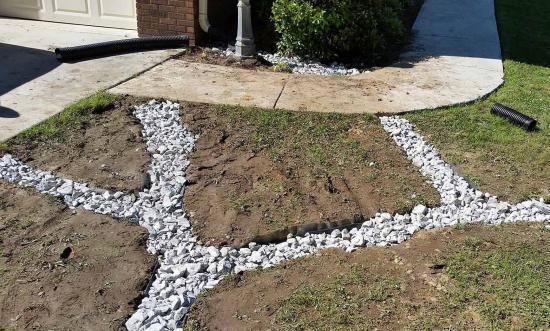
Stages of creating an open drainage system:
- Marking the site according to the plan for the location of future trenches;
- Digging trenches with a semicircular bottom 50 cm deep;
- Lining the entire surface of the trench with geotextile, filling it with crushed stone and re-coating it with a second layer of tecton.
- Next, sand is poured onto which turf can be laid, and, if necessary, a geogrid.
Features: the slope of the pipes should be 1 cm per linear meter. The same system can be built without the use of textile fabric.
The advantages of the method are ease of arrangement, low manufacturing cost, and no special knowledge is required for construction.
How to dry an area with your own hands, how to remove water
The frequency of periods during which it is necessary to remove water from the site depends on the type of soil, location of the site, topography, availability of finances and willingness to invest in the drainage system.
To remove water from the site, you need to build an effective wastewater complex that will collect water throughout the site and direct it through highways to collectors.
When starting work, you need to determine what type of drainage will be optimal for the site. This takes into account its size, the amount of rain and wastewater, the frequency of their occurrence, and the presence of underground water sources.
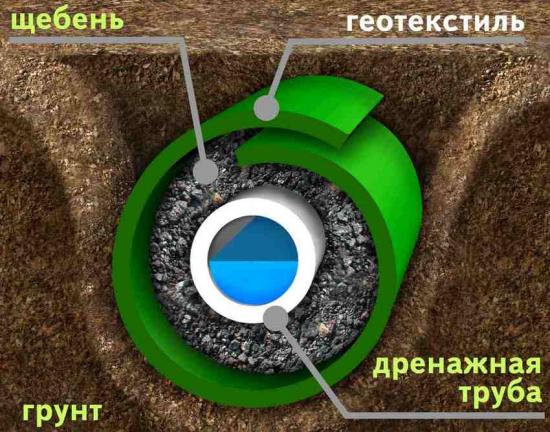
The best solution is a combination of surface and deep methods of laying drainage communications.
Underground pipes will provide optimal moisture content to the soil without attracting attention to themselves. And surface drainage trenches can be integrated into the landscape, turning them into picturesque channels lined with decorative stone.
Surface gutters equipped with geotextiles, sand and crushed stone not only drain water, but also filter it, allowing the wastewater that accumulates in the collector to be used for technical needs: watering plants and washing floors and cars.
Let's watch a video about the construction of the drainage system on the site:
How to get rid of water on a site using point and linear drainage
The elements of the surface drainage system are local point and linear devices.
Point hydraulic structures are designed in places where puddles accumulate, under roof drains, on concrete areas and under irrigation taps.
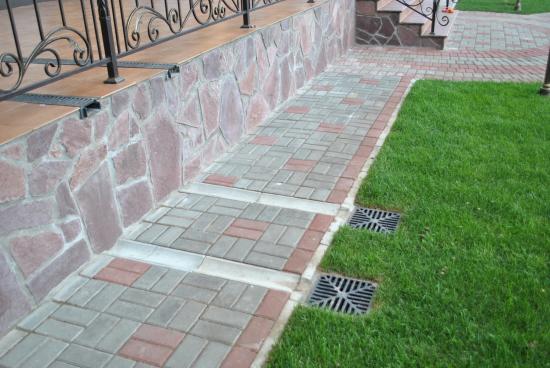
In point hydraulic drainage structures, a concrete base is installed to serve as a waterproof base for a small collector that collects water.
Water from a point drainage collector is discharged through main pipes.
Linear drainage is an almost invisible and very effective system of trench-trenches, covered on top with gratings to prevent leaves, grass and debris from entering. The accumulation and subsequent drainage of water into storage collectors is achieved by tilting the channel itself, as well as by arranging paths and platforms at a slight angle.
Such drainage is quite expensive due to the need to purchase decorative and protective drain gratings and main pipes.
Advantages: the system of surface point and linear drainage looks very respectable, can be built on its own, operates efficiently, and is easy to clean.
How to install a water drainage system around the house
Sewage, stormwater and groundwater, accumulating around the foundation of a house, can cause destruction to the structure.
Drainage systems built around the house are dug in the form of a trench having a depth of 30-50 cm above the base of the foundation. The tilt angle is 1 cm per linear meter. The side adjacent to the foundation is carefully waterproofed.
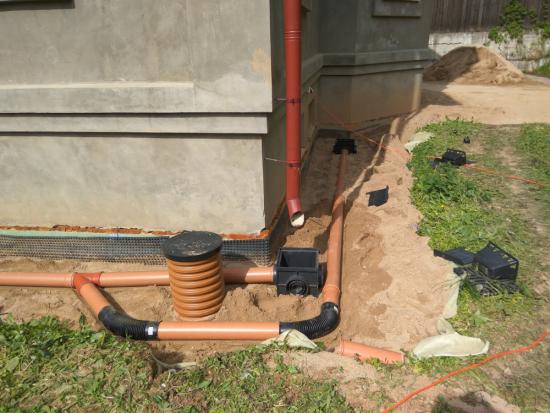 Storm drains around the house can be arranged with or without special pipes. The choice of option depends on the financial capabilities and desires of the homeowner.
Storm drains around the house can be arranged with or without special pipes. The choice of option depends on the financial capabilities and desires of the homeowner.
When constructing a backfill storm drain, the bottom of the trench is rounded and compacted by compaction or concreting. Coarse gravel is poured onto it, finer crushed stone is placed higher, then fine drainage, completely hiding the trench.
You can also lay perforated pipes in the prepared ditch around the walls of the house, which will accumulate groundwater and wastewater. The most popular option is PVC pipes with a filter braid.
Let's watch a video on how to make drainage around the house:
A do-it-yourself stormwater complex will provide reliable protection for your site. It must be remembered that any materials used in the construction of drainage systems must be of high quality.
Saving on hidden work can lead to large financial losses in the future.

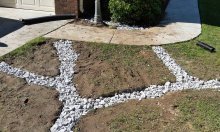
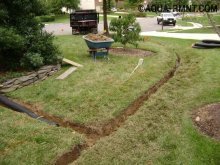
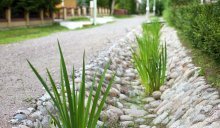
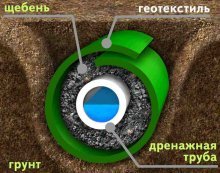
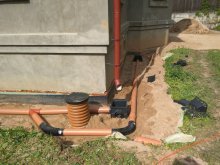
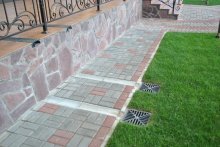
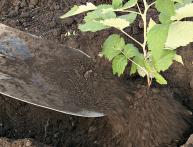







Comments
The simplest way to reduce water on a site is to dig a small pond. The second way is to dig drainage trenches around the perimeter of the site. Such measures will lower the groundwater level by at least half a meter.